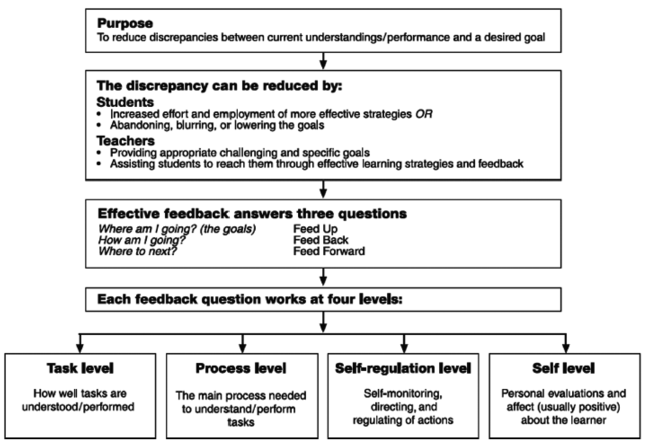Navigating Feedback to Move Learning Forward
May 25, 2022Providing feedback during the learning process has the potential to move student learning forward. The roadblock, for most students and teachers, is that our feedback doesn't necessarily provide clear steps for improvement or provided at the right phase in learning.
In an EdWeek interview, John Hattie said, "When teachers spend hours and hours writing comments, if there’s no feedback providing concrete steps for the students to improve, students will argue themselves blue in the face that they never received anything. The key question is, does feedback help someone understand what they don’t know, what they do know, and where they go? That’s when and why feedback is so powerful, but a lot of feedback doesn’t—and doesn’t have any effect" (Sparks).
There are generally three different stages of feedback for learning: Task, Process, Self-Regulation. Each phase is most effective when it is targeted at the level the student is working at. The task-level process is very surface-level learning and was rooted mostly in making sure students understood the task and the tools we were using.
This early feedback was mostly task-based and would hopefully help the students feel like they are being seen and also "coached" towards success -- we were giving them what their next step was. From this point on, the project became more about their thinking and process-based, which is inherently more personal. If we didn't hook them in the beginning it would've been harder to help them feel successful later.
In a recent PBL research project, we tried our best to provide the right feedback for students at the right time. This meant our team divided up our group of students in order to confer and work with each student through the feedback.
This project was very early in the project, so it was more task-driven. The students we chose to work with: (a) haven't found success in the research yet; (b) didn't know how to use NoodleTools; (c) didn't like their topic. The goal for this check-in was to help them get unstuck and get moving.
You can grab a copy of our Task-Level Feedback, or just checkout the Google Doc HERE. I also helped teachers by providing prompts and questions to guide them through the initial check-in. There were also several examples that were accessible digitally on their iPads and tangibly around the room to review what we had previously discussed in class.
If you are looking for more on feedback, I would suggest Rigorous PBL by Design by Michael McDowell and Visible Learning: Feedback by John Hattie. If you are looking for more on clarifying the learning for students, check out Clarity for Learning by Kara Vandas. You can read more about the levels of feedback here.
References:
- Hattie, J., & Clarke, S. (2019). Visible learning: Feedback. Routledge.
- Sparks, S. D. (2021, September 1). Getting feedback right: A Q&A with John Hattie. Education Week. Retrieved June 24, 2022, from https://www.edweek.org/leadership/getting-feedback-right-a-q-a-with-john-hattie/2018/06





0 comments